Enhancement of Viscoelastic and Electrical Properties of Magnetorheological Elastomers with Nanosized Ni-Mg Cobalt-Ferrites as Fillers
Abstract
1. Introduction
2. Methodology
2.1. Samples Preparation
2.2. Samples Characterization
3. Results and Discussion
3.1. Morphological Properties
3.2. Magnetic Properties
3.3. Sweep Strain
3.4. Sweep Current
3.5. Electrical Resistance of the MRE Samples
4. Conclusions
Author Contributions
Funding
Acknowledgments
Conflicts of Interest
References
- Sun, S.; Deng, H.; Yang, J.; Li, W.; Du, H.; Alici, G. Performance evaluation and comparison of magnetorheological elastomer absorbers working in shear and squeeze modes. J. Intell. Mater. Syst. Struct. 2015, 26, 1757–1763. [Google Scholar] [CrossRef]
- Wahab, N.A.A.; Mazlan, S.A.; Ubaidillah, U.; Kamaruddin, S.; Ismail, N.I.N.; Choi, S.B.; Sharif, A.H.R. Fabrication and investigation on field-dependent properties of natural rubber based magneto-rheological elastomer isolator. Smart Mater. Struct. 2016, 25, 107002. [Google Scholar] [CrossRef]
- Yang, J.; Sun, S.S.; Du, H.; Li, W.H.; Alici, G.; Deng, H.X. A novel magnetorheological elastomer isolator with negative changing stiffness for vibration reduction. Smart Mater. Struct. 2014, 23, 105023. [Google Scholar] [CrossRef]
- Shabdin, M.K.; Rahman, M.A.A.; Mazlan, S.A.; Ubaidillah; Hapipi, N.M.; Adiputra, D.; Aziz, S.A.A.; Bahiuddin, I.; Choi, S.B. Material characterizations of gr-based magnetorheological elastomer for possible sensor applications: Rheological and resistivity properties. Materials 2019, 12, 391. [Google Scholar] [CrossRef] [PubMed]
- Wang, Y.; Zhang, X.; Oh, J.; Chung, K. Fabrication and properties of magnetorheological elastomers based on CR/ENR self-crosslinking blends. Smart Mater. Struct. 2015, 24, 095006. [Google Scholar] [CrossRef]
- Tian, T.F.; Zhang, X.Z.; Li, W.H.; Alici, G.; Ding, J. Study of PDMS based magnetorheological elastomers. J. Phys. Conf. Ser. 2013, 412, 012038. [Google Scholar] [CrossRef]
- Jung, H.S.; Kwon, S.H.; Choi, H.J.; Jung, J.H.; Kim, Y.G. Magnetic carbonyl iron/natural rubber composite elastomer and its magnetorheology. Compos. Struct. 2016, 136, 106–112. [Google Scholar] [CrossRef]
- Zaborski, M.; Pietrasik, J.; Masłowski, M. Elastomers containing fillers with magnetic properties. Solid State Phenom. 2009, 154, 121–126. [Google Scholar] [CrossRef]
- Koo, J.H.; Dawson, A.; Jung, H.J. Characterization of actuation properties of magnetorheological elastomers with embedded hard magnetic particles. J. Intell. Mater. Syst. Struct. 2012, 23, 1049–1054. [Google Scholar] [CrossRef]
- Kramarenko, E.Y.; Chertovich, A.V.; Stepanov, G.V.; Semisalova, A.S.; Makarova, L.A.; Perov, N.S.; Khokhlov, A.R. Magnetic and viscoelastic response of elastomers with hard magnetic filler. Smart Mater. Struct. 2015, 24, 035002. [Google Scholar] [CrossRef]
- Jin, Q.; Xu, Y.G.; Di, Y.; Fan, H. Influence of the particle size on the rheology of magnetorheological elastomer. Mater. Sci. Forum 2014, 809–810, 757–763. [Google Scholar] [CrossRef]
- Hapipi, N.; Aziz, S.A.A.; Mazlan, S.A.; Ubaidillah; Choi, S.B.; Mohamad, N.; Khairi, M.H.A.; Fatah, A.Y.A. The field-dependent rheological properties of plate-like carbonyl iron particle-based magnetorheological elastomers. Results Phys. 2019, 12, 2146–2154. [Google Scholar] [CrossRef]
- Borin, D.; Kolsch, N.; Stepanov, G.; Odenbach, S. On the oscillating shear rheometry of magnetorheological elastomers. Rheol. Acta 2018, 57, 217–227. [Google Scholar] [CrossRef]
- Tong, Y.; Dong, X.; Qi, M. Improved tunable range of the field-induced storage modulus by using flower-like particles as the active phase of magnetorheological elastomers. Soft Matter 2018, 14, 3504–3509. [Google Scholar] [CrossRef]
- Sapouna, K.; Xiong, Y.P.; Shenoi, R.A. Dynamic mechanical properties of isotropic/anisotropic silicon magnetorheological elastomer composites. Smart Mater. Struct. 2017, 26, 115010. [Google Scholar] [CrossRef]
- Naimzad, A.; Hojjat, Y.; Ghodsi, M. Comparative study on mechanical and magnetic properties of porous and nonporous film-shaped magnetorheological nanocomposites based on silicone rubber. Int. J. Innov. Sci. Mod. Eng. 2014, 2, 11–20. [Google Scholar]
- Schubert, G.; Harrison, P. Large-strain behaviour of magneto-rheological elastomers tested under uniaxial compression and tension, and pure shear deformations. Polym. Test. 2015, 42, 122–134. [Google Scholar] [CrossRef]
- Kaur, R.; Hasan, A.; Iqbal, N.; Alam, S.; Saini, M.K.; Raza, S.K. Synthesis and surface engineering of magnetic nanoparticles for environmental cleanup and pesticide residue analysis: A review. J. Sep. Sci. 2014, 37, 1805–1825. [Google Scholar] [CrossRef]
- Allia, P.; Barrera, G.; Tiberto, P.; Nardi, T.; Leterrier, Y.; Sangermano, M. Fe3O4 nanoparticles and nanocomposites with potential application in biomedicine and in communication technologies: Nanoparticle aggregation, interaction, and effective magnetic anisotropy. J. Appl. Phys. 2014, 116, 113903. [Google Scholar] [CrossRef]
- Laurent, S.; Forge, D.; Port, M.; Roch, A.; Robic, C.; Vander Elst, L.; Muller, R.N. magnetic iron oxide nanoparticles: Synthesis, stabilization, vectorization, physicochemical characterizations, and biological applications. Chem. Rev. 2008, 108, 2064–2110. [Google Scholar] [CrossRef]
- Mordina, B.; Tiwari, R.K.; Setua, D.K.; Sharma, A. Superior elastomeric nanocomposites with electrospun nanofibers and nanoparticles of CoFe2O4 for magnetorheological applications. RSC Adv. 2015, 5, 19091–19105. [Google Scholar] [CrossRef]
- Akther Hossain, A.K.M.; Seki, M.; Kawai, T.; Tabata, H. Colossal magnetoresistance in spinel type Zn1−xNixFe2O4. J. Appl. Phys. 2004, 96, 1273–1275. [Google Scholar] [CrossRef]
- John Berchmans, L.; Kalai Selvan, R.; Selva Kumar, P.; Augustin, C. Structural and electrical properties of Ni1−xMgxFe2O4 synthesized by citrate gel process. J. Magn. Magn. Mater. 2004, 279, 103–110. [Google Scholar] [CrossRef]
- Tian, T.F.; Li, W.H.; Deng, Y.M. Sensing capabilities of graphite based MR elastomers. Smart Mater. Struct. 2011, 20, 025022. [Google Scholar] [CrossRef]
- Ahmad Khairi, M.H.; Mazlan, S.A.; Ubaidillah; Ku Ahmad, K.Z.; Choi, S.B.; Abdul Aziz, S.A.; Yunus, N.A. The field-dependent complex modulus of magnetorheological elastomers consisting of sucrose acetate isobutyrate ester. J. Intell. Mater. Syst. Struct. 2017, 28, 1993–2004. [Google Scholar] [CrossRef]
- Wang, Y.; Xuan, S.; Dong, B.; Xu, F.; Gong, X. Stimuli dependent impedance of conductive magnetorheological elastomers. Smart Mater. Struct. 2016, 25, 025003. [Google Scholar] [CrossRef]
- Aziz, S.A.A.; Mazlan, S.A.; Ismail, N.I.N.; Ubaidillah; Choi, S.B.; Nordin, N.A.; Mohamad, N. A comparative assessment of different dispersing aids in enhancing magnetorheological elastomer properties. Smart Mater. Struct. 2018, 27, 117002. [Google Scholar] [CrossRef]
- Poojary, U.R.; Hegde, S.; Gangadharan, K.V. Experimental investigation on the effect of carbon nanotube additive on the field-induced viscoelastic properties of magnetorheological elastomer. J. Mater. Sci. 2018, 53, 4229–4241. [Google Scholar] [CrossRef]
- Li, R.; Sun, L.Z. Dynamic viscoelastic behavior of multiwalled carbon nanotube–reinforced magnetorheological (MR) nanocomposites. J. Nanomech. Micromech. 2014, 4, A4013014. [Google Scholar] [CrossRef]
- Aziz, S.A.A.; Ubaidillah, U.; Mazlan, S.A.; Ismail, N.I.N.; Choi, S. Implementation of functionalized multiwall carbon nanotubes on magnetorheological elastomer. J. Mater. Sci. 2018, 53, 10122–10134. [Google Scholar] [CrossRef]
- Abdul Aziz, S.A.; Mazlan, S.A.; Nik Ismail, N.I.; Choi, S.B.; Ubaidillah, U.; Yunus, N.A.B. An enhancement of mechanical and rheological properties of magnetorheological elastomer with multiwall carbon nanotubes. J. Intell. Mater. Syst. Struct. 2017, 28, 3127–3138. [Google Scholar] [CrossRef]
- Padalka, O.; Song, H.J.; Wereley, N.M.; Filer II, J.A.; Bell, R.C. Stiffness and damping in Fe, Co, and Ni nanowire-based magnetorheological elastomeric composites. IEEE Trans. Magn. 2010, 46, 2275–2277. [Google Scholar] [CrossRef]
- Yu, M.; Zhu, M.; Fu, J.; Yang, P.A.; Qi, S. A dimorphic magnetorheological elastomer incorporated with Fe nano-flakes modified carbonyl iron particles: Preparation and characterization. Smart Mater. Struct. 2015, 24, 115021. [Google Scholar] [CrossRef]
- Li, W.; Kostidis, K.; Zhang, X.; Zhou, Y. Development of a Force Sensor Working with MR Elastomers. In Proceedings of the 2009 IEEE/ASME International Conference on Advanced Intelligent Mechatronics, Singapore, 14–17 July 2009; pp. 233–238. [Google Scholar]
- Tian, T.F.; Li, W.H.; Alici, G. Study of magnetorheology and sensing capabilities of MR elastomers. J. Phys. Conf. Ser. 2013, 412, 012037. [Google Scholar] [CrossRef]
- Li, W.; Tian, T.; Du, H. Sensing and rheological capabilities of MR elastomers. In Smart Actuation and Sensing Systems - Recent Advances and Future Challenges; InTech: London, UK, 2012. [Google Scholar]
- Rosnan, R.M.; Othaman, Z.; Hussin, R.; Ati, A.A.; Samavati, A.; Dabagh, S.; Zare, S. Effects of Mg substitution on the structural and magnetic properties of Co0.5Ni0.5 − xMgxFe2O4 nanoparticle ferrites. Chinese Phys. B 2016, 25, 047501. [Google Scholar] [CrossRef]
- Andersson, S. Spin-Diode Effect and Thermally Controlled Switching in Magnetic Spin-Valves. Ph.D. Thesis, KTH Applied Physics, Stockholm, Sweden, March 2012. [Google Scholar]
- Liu, T.; Esposito, C.I.; Burket, J.C.; Wright, T.M. Crosslink density is reduced and oxidation is increased in retrieved highly crosslinked polyethylene TKA tibial inserts. Clin. Orthop. Relat. Res. 2017, 475, 128–136. [Google Scholar] [CrossRef]
- Mujtaba, A.; Keller, M.; Ilisch, S.; Radusch, H.J.; Thurn-Albrecht, T.; Saalwächter, K.; Beiner, M. Mechanical properties and cross-link density of styrene–butadiene model composites containing fillers with bimodal particle size distribution. Macromolecules 2012, 45, 6504–6515. [Google Scholar] [CrossRef]
- Agarwal, G.; Patnaik, A.; kumar Sharma, R.; Agarwal, J. Effect of stacking sequence on physical, mechanical and tribological properties of glass-carbon hybrid composites. Friction 2014, 2, 354–364. [Google Scholar] [CrossRef]
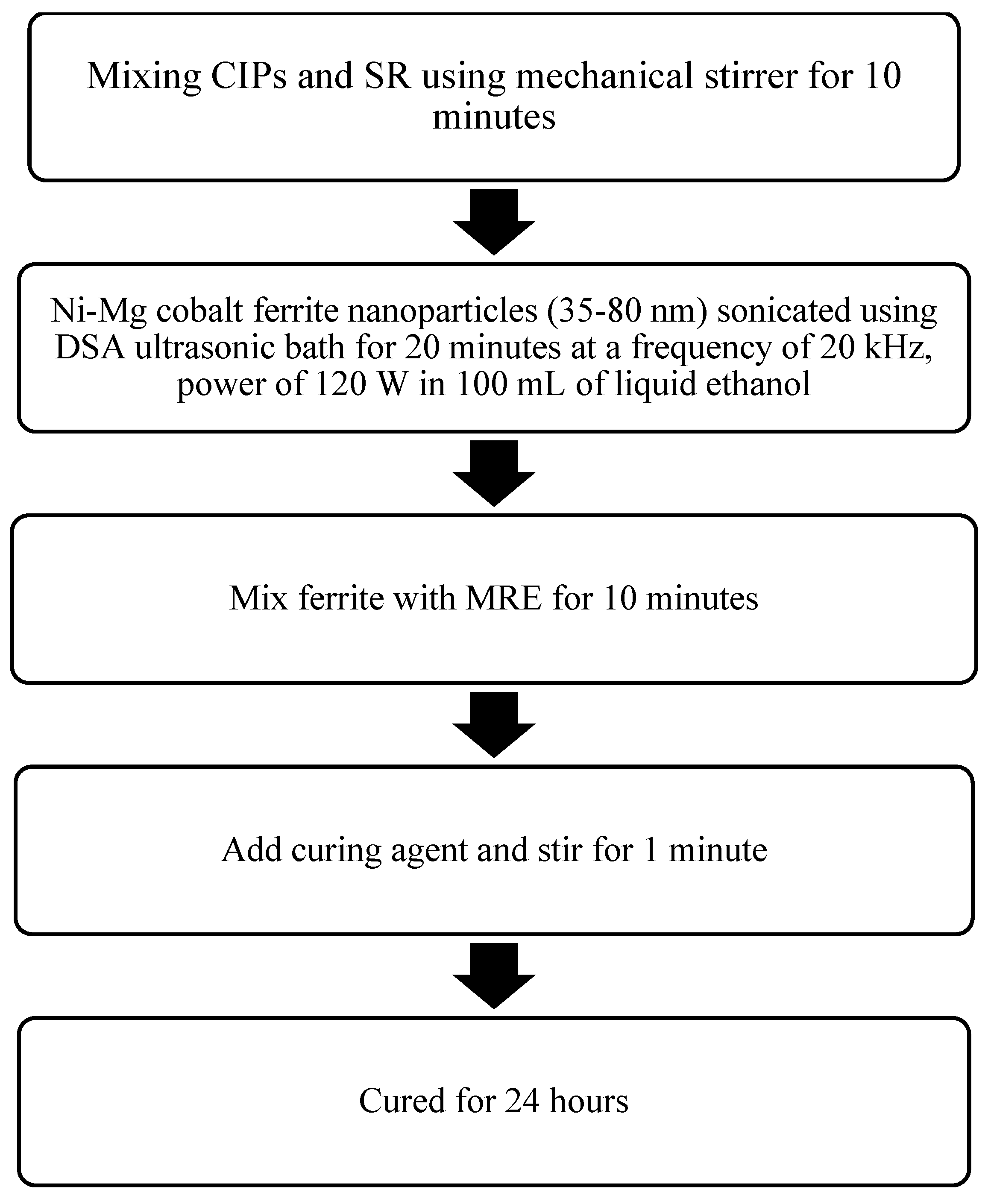

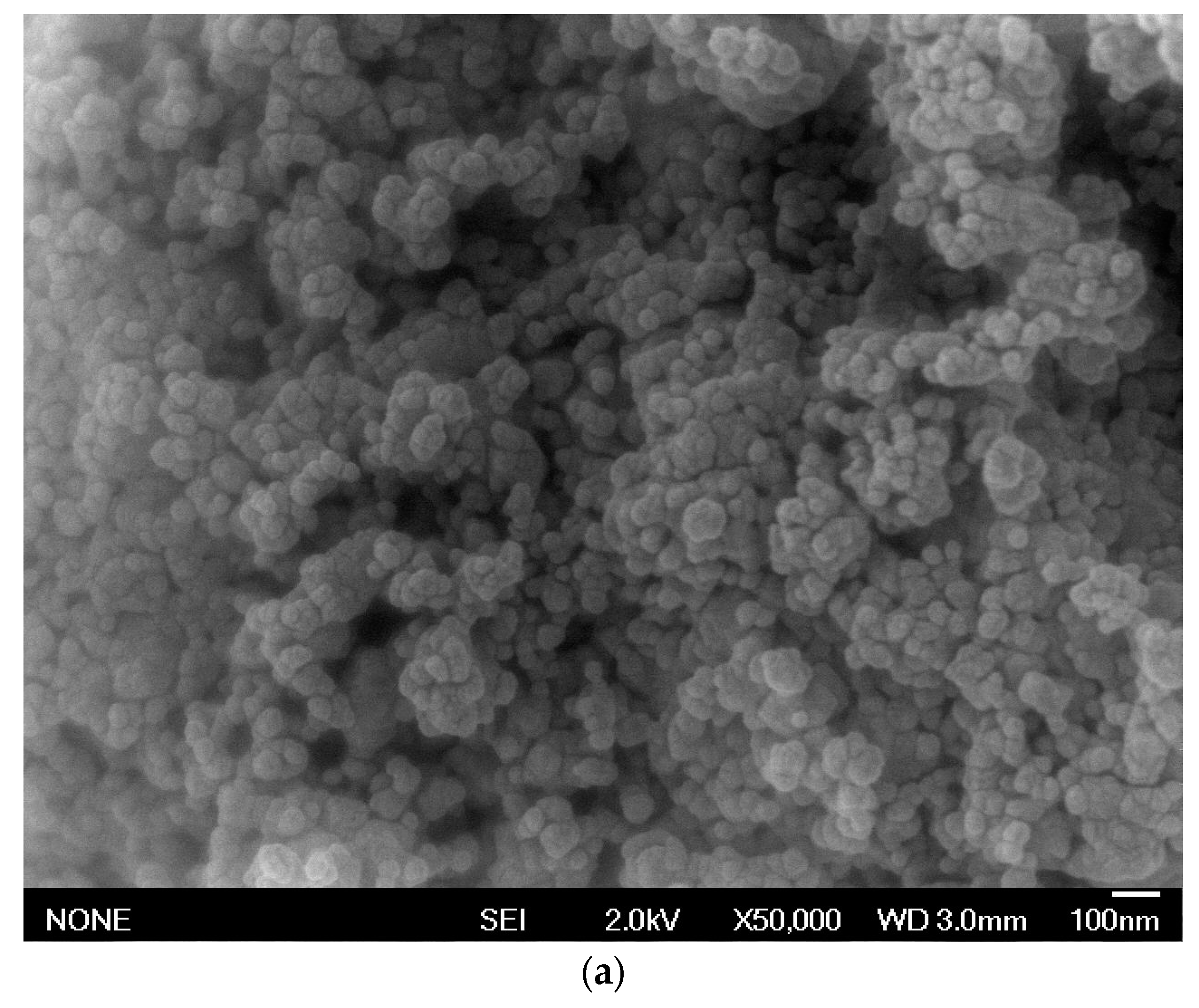
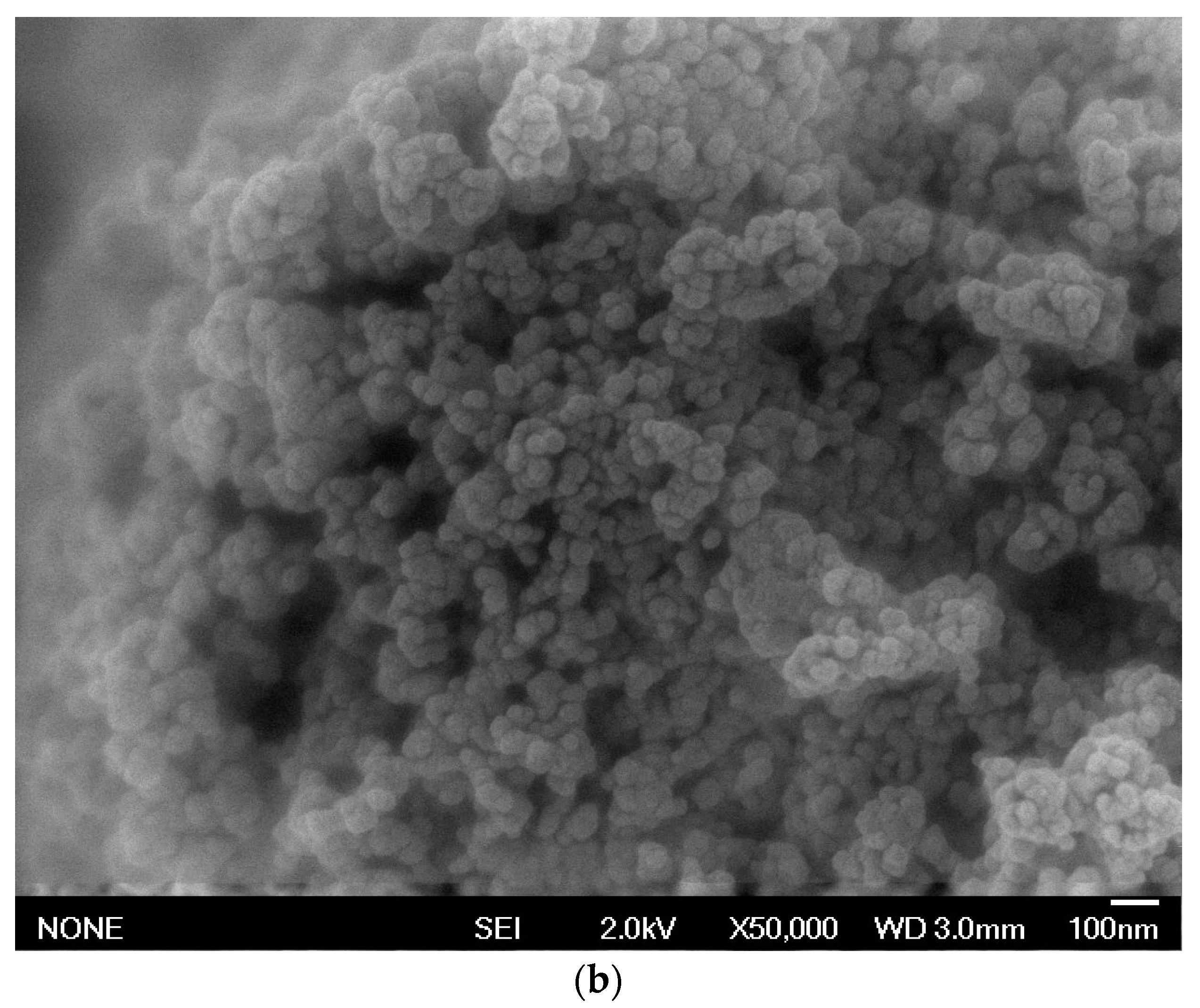
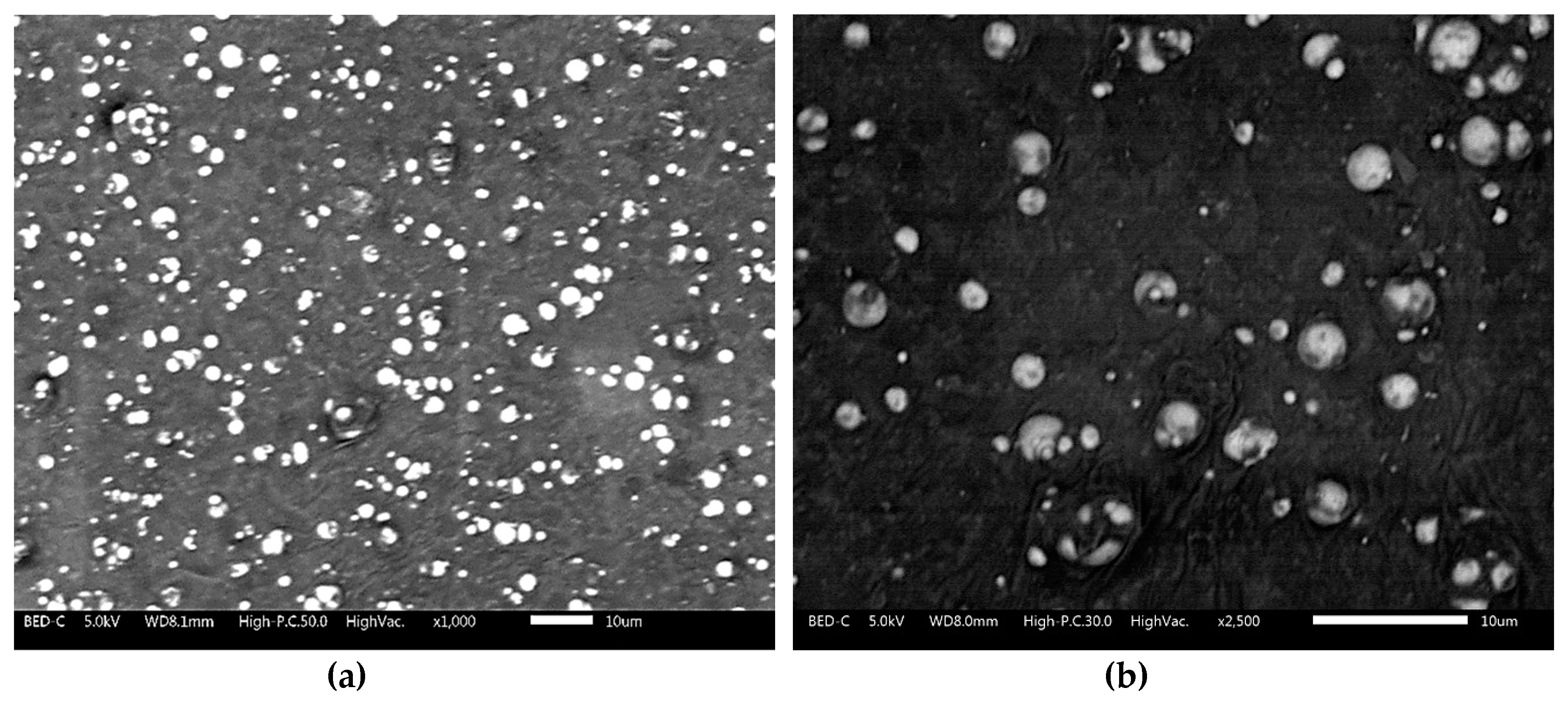

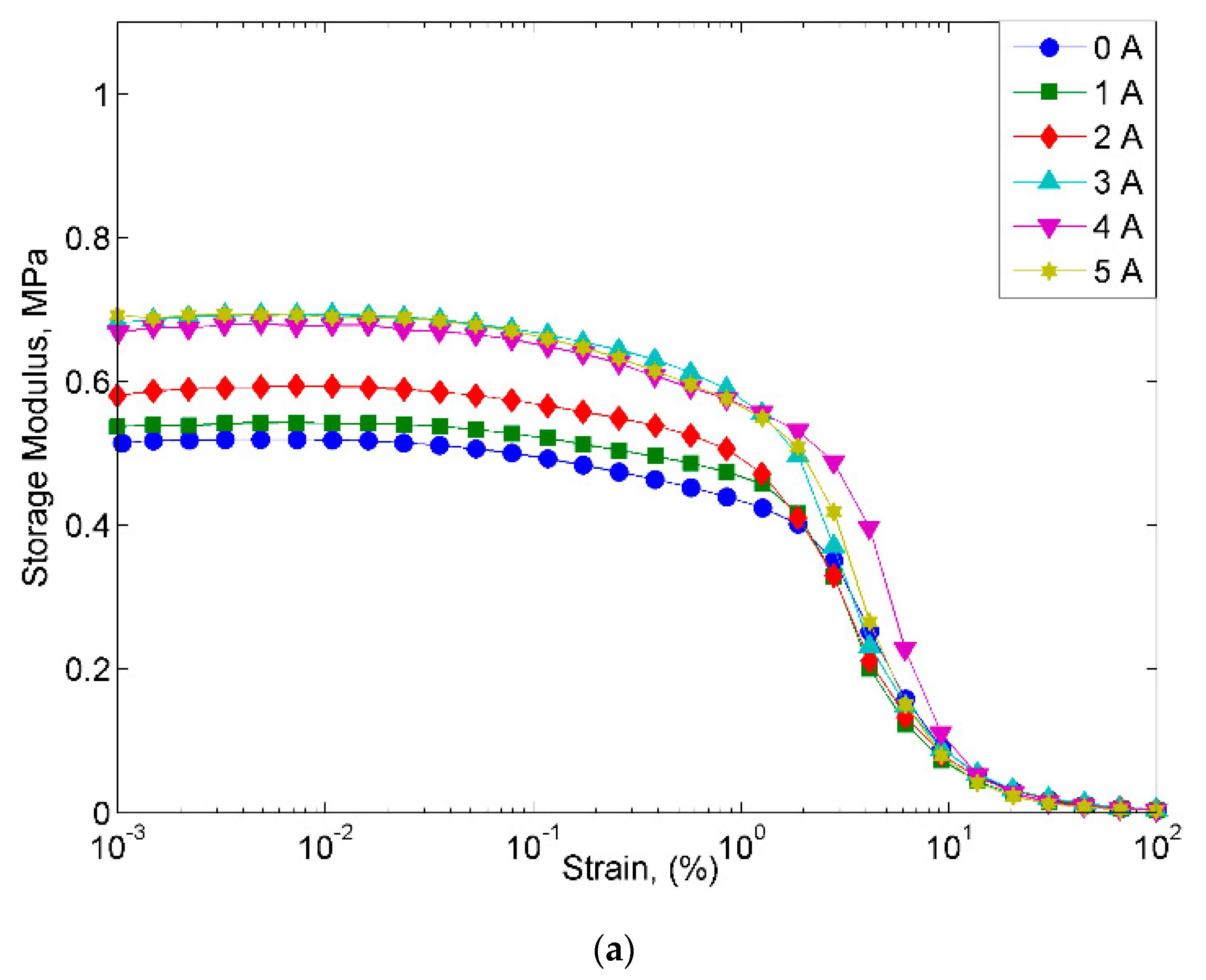
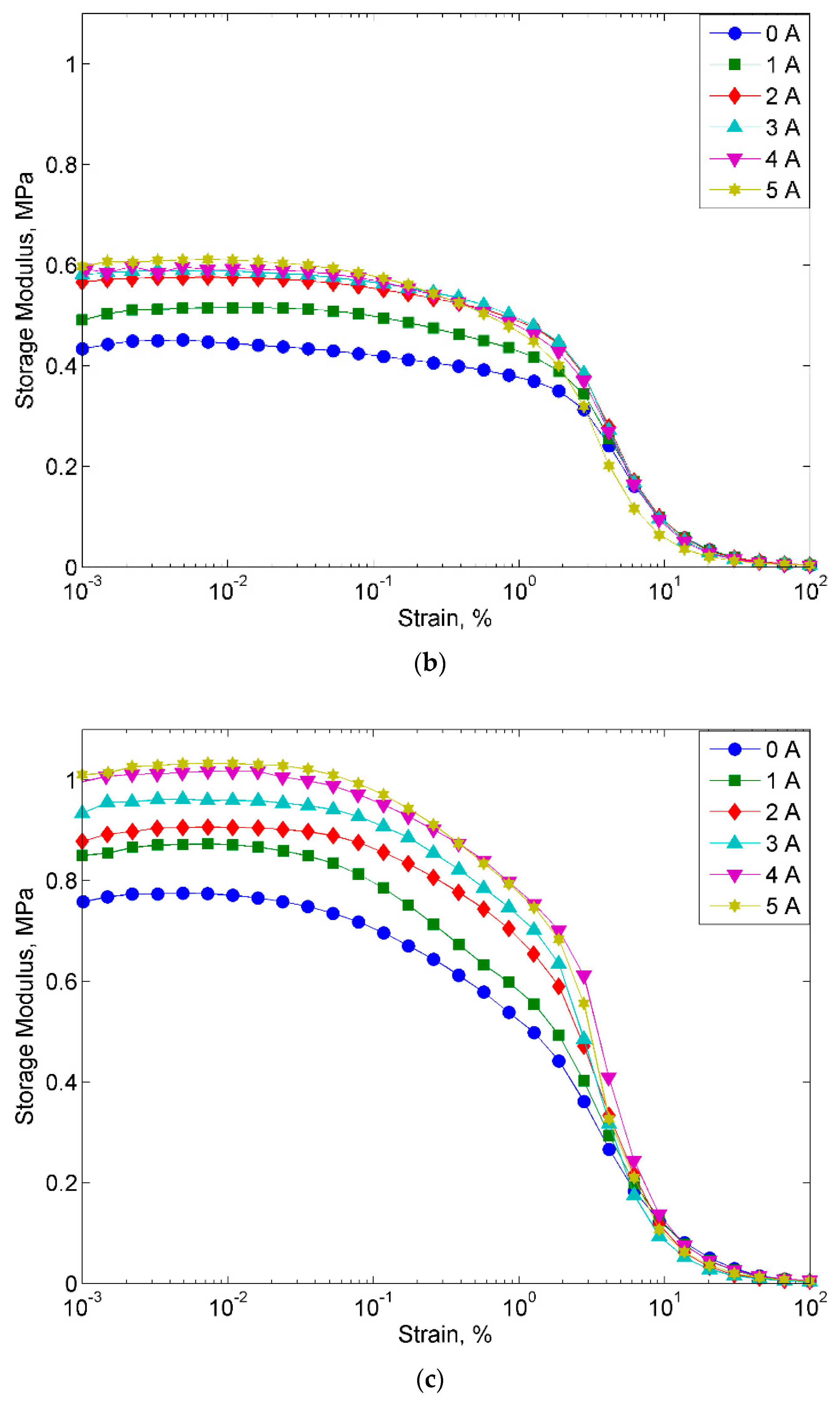
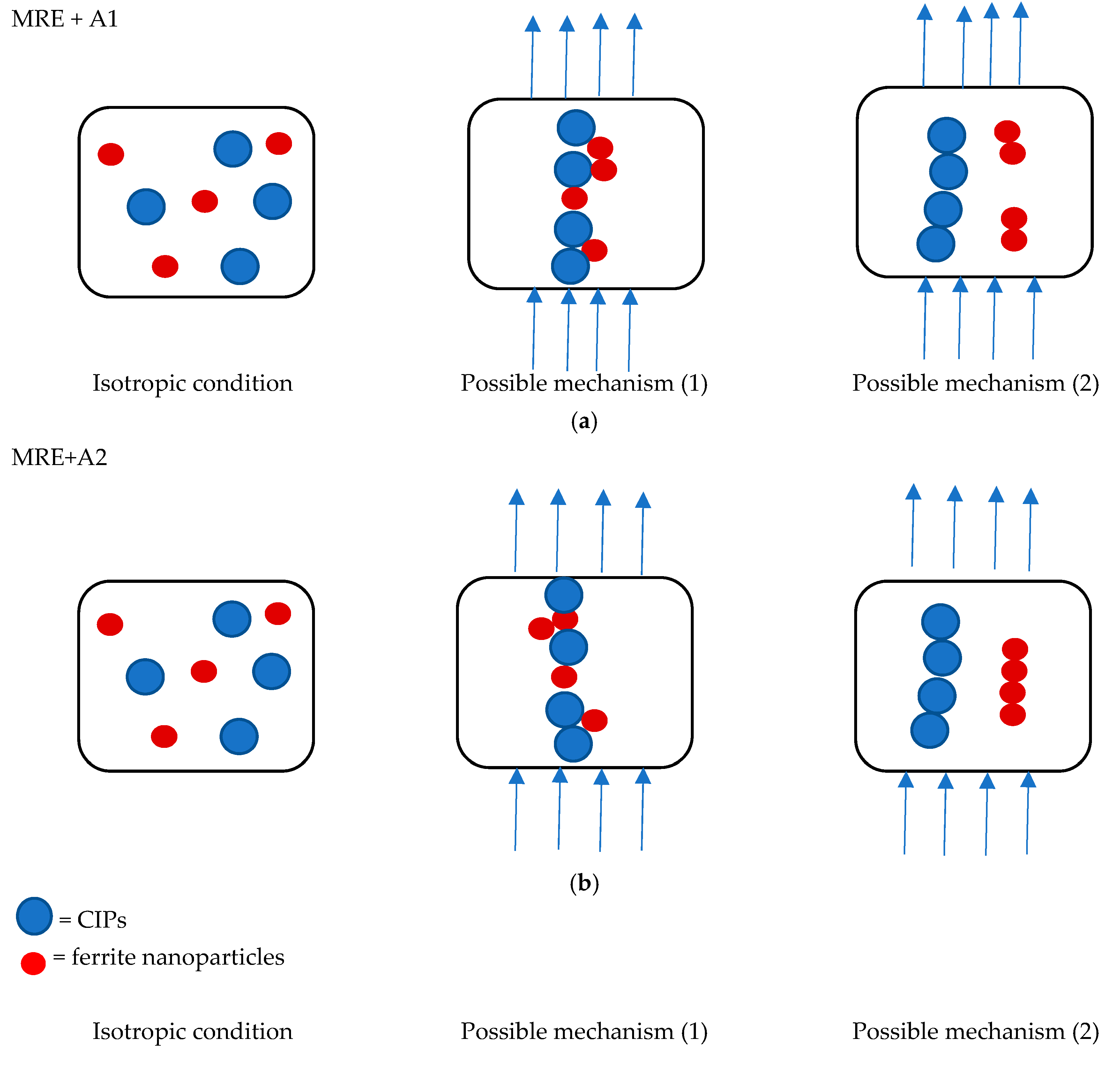

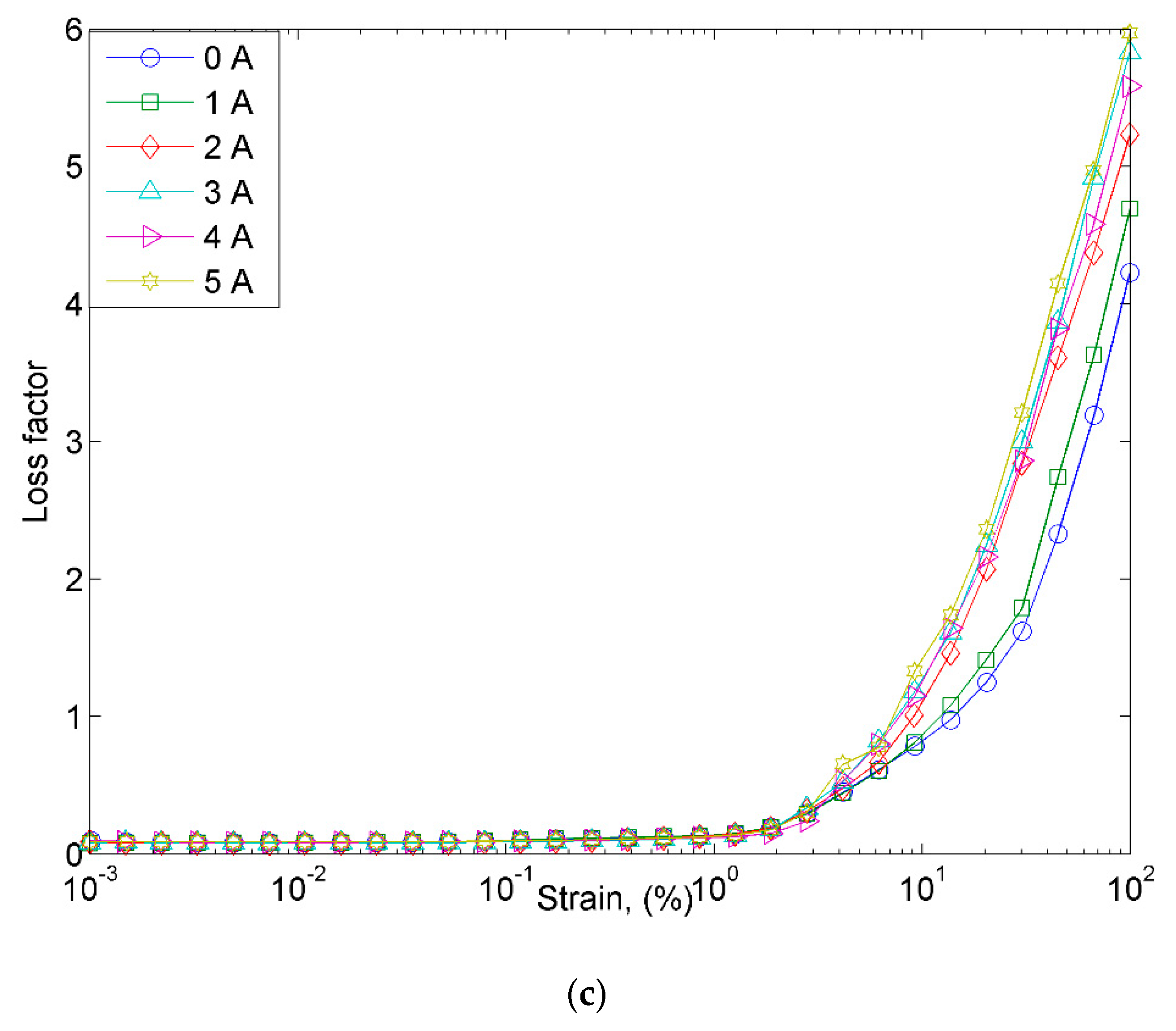
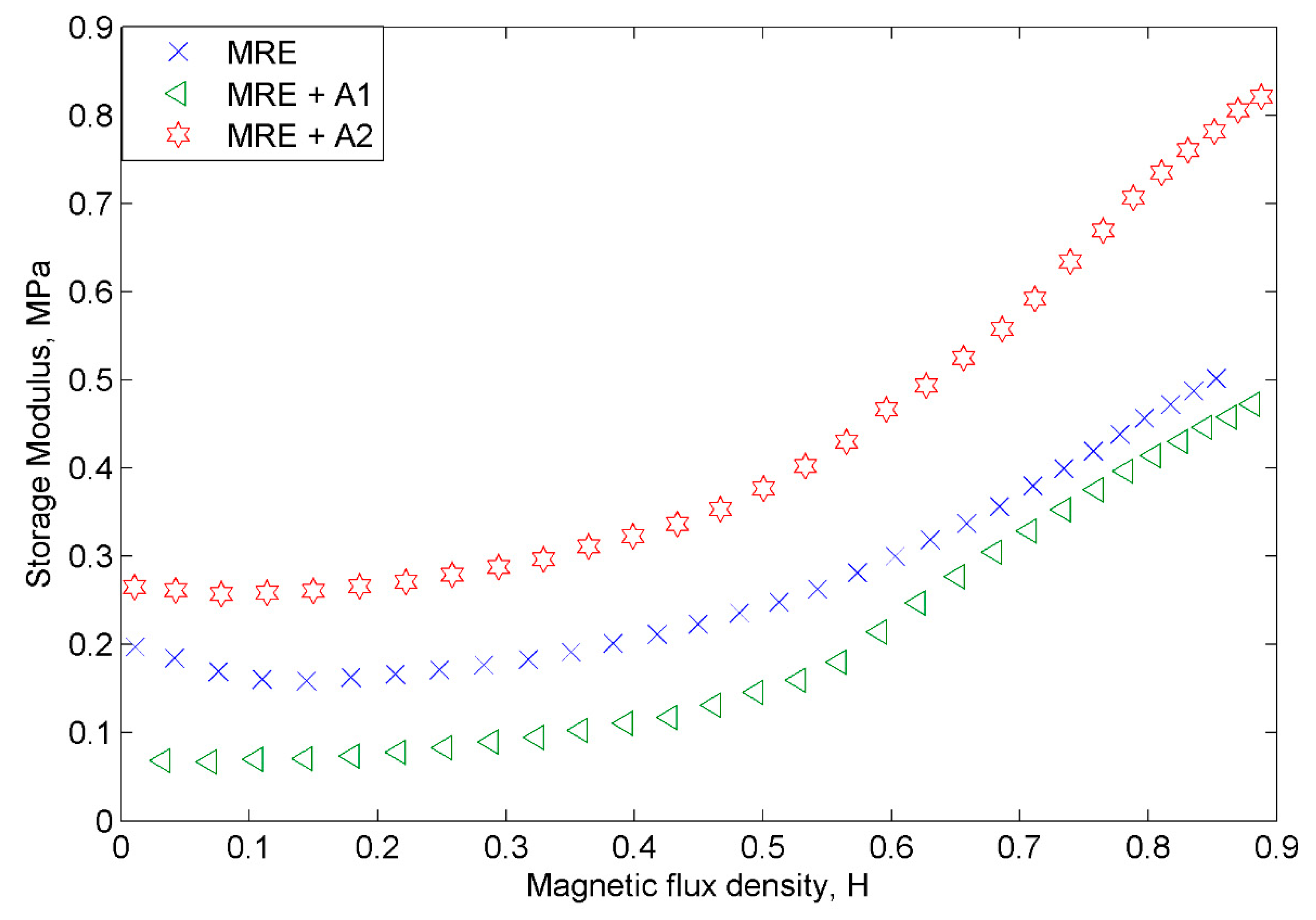
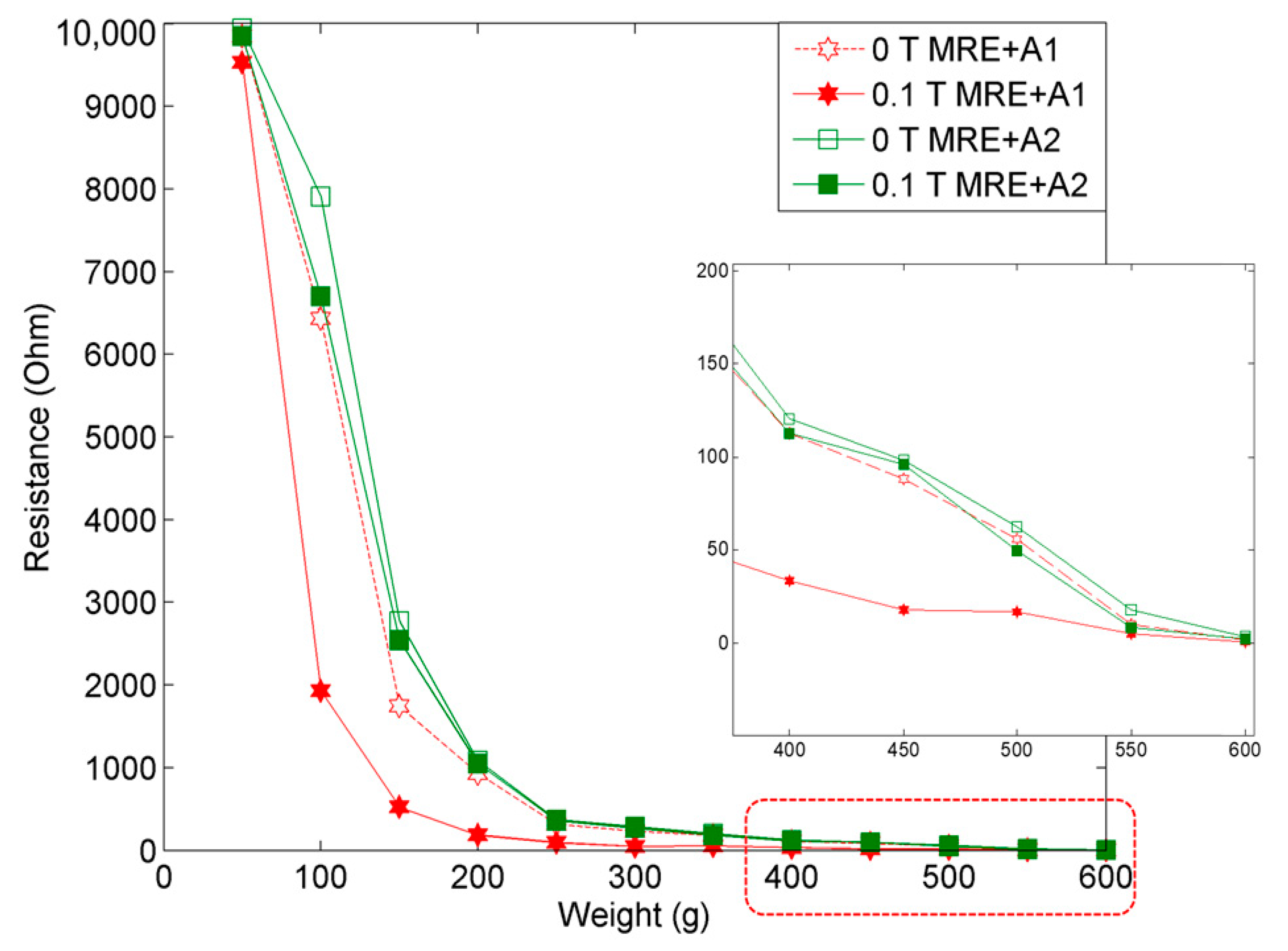
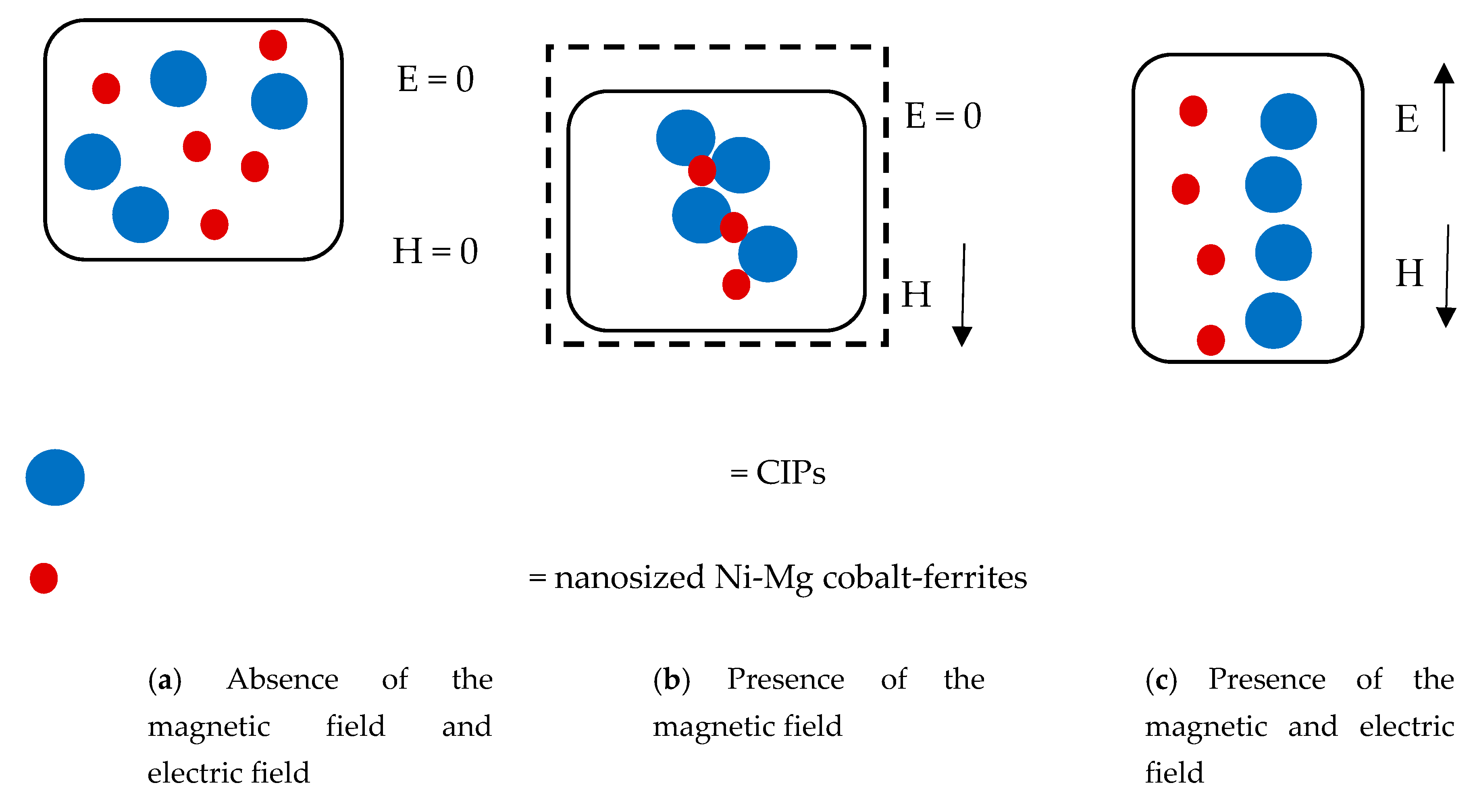
| Samples | Magnetic Flux Densities (T) | |||||
|---|---|---|---|---|---|---|
| Current (A) | ||||||
| 0 | 1 | 2 | 3 | 4 | 5 | |
| MRE | 0 | 0.211 | 0.412 | 0.599 | 0.748 | 0.854 |
| MRE + A1 | 0 | 0.209 | 0.411 | 0.598 | 0.773 | 0.884 |
| MRE + A2 | 0 | 0.214 | 0.416 | 0.608 | 0.774 | 0.889 |
| Samples | MRE | A1 [37] | MRE + A1 | A2 [37] | MRE + A2 |
|---|---|---|---|---|---|
| Ms (Am2/kg) | 140.25 | 47.34 | 143.92 | 54.62 | 143.77 |
| Mr (Am2/kg) | 0.32 | 26.41 | 0.61 | 29.13 | 0.59 |
| Hc (Oe) | 8.70 | 621.27 | 15.71 | 608.17 | 15.33 |
| Samples | G0 (MPa) | ΔG (MPa) | MR Effect (%) |
|---|---|---|---|
| MRE | 0.19 | 0.30 | 157.89 |
| MRE + A1 | 0.07 | 0.40 | 571.43 |
| MRE + A2 | 0.26 | 0.56 | 215.38 |
| Samples/Weight (g) | MRE + A1 | MRE + A2 | ||
|---|---|---|---|---|
| 0 T | 0.1 T | 0 T | 0.1 T | |
| 50 | 9848.63 Ω | 9533.67 Ω | 9938.91 Ω | 9845.05 Ω |
| 100 | 6431.33 Ω | 1929.30 Ω | 7906.90 Ω | 6698.81 Ω |
| 150 | 1744.36 Ω | 523.21 Ω | 2771.35 Ω | 2537.91 Ω |
| 200 | 929.08 Ω | 185.84 Ω | 1085.38 Ω | 1048.48 Ω |
| 250 | 314.55 Ω | 94.25 Ω | 369.11 Ω | 359.45 Ω |
| 300 | 232.83 Ω | 46.43 Ω | 285.56 Ω | 268.98 Ω |
| 350 | 180.45 Ω | 54.03 Ω | 200.62 Ω | 183.40 Ω |
| 400 | 112.82 Ω | 33.67 Ω | 120.34 Ω | 112.86 Ω |
| 450 | 88.15 Ω | 17.69 Ω | 98.26 Ω | 96.01 Ω |
| 500 | 55.68 Ω | 16.58 Ω | 62.66 Ω | 49.30 Ω |
| 550 | 10.12 Ω | 5.06 Ω | 17.81 Ω | 8.17 Ω |
| 600 | 1.73 Ω | 0.20 Ω | 3.02 Ω | 2.37 Ω |
© 2019 by the authors. Licensee MDPI, Basel, Switzerland. This article is an open access article distributed under the terms and conditions of the Creative Commons Attribution (CC BY) license (http://creativecommons.org/licenses/by/4.0/).
Share and Cite
Abdul Aziz, S.A.; Mazlan, S.A.; Ubaidillah, U.; Shabdin, M.K.; Yunus, N.A.; Nordin, N.A.; Choi, S.-B.; Rosnan, R.M. Enhancement of Viscoelastic and Electrical Properties of Magnetorheological Elastomers with Nanosized Ni-Mg Cobalt-Ferrites as Fillers. Materials 2019, 12, 3531. https://doi.org/10.3390/ma12213531
Abdul Aziz SA, Mazlan SA, Ubaidillah U, Shabdin MK, Yunus NA, Nordin NA, Choi S-B, Rosnan RM. Enhancement of Viscoelastic and Electrical Properties of Magnetorheological Elastomers with Nanosized Ni-Mg Cobalt-Ferrites as Fillers. Materials. 2019; 12(21):3531. https://doi.org/10.3390/ma12213531
Chicago/Turabian StyleAbdul Aziz, Siti Aishah, Saiful Amri Mazlan, U Ubaidillah, Muhammad Kashfi Shabdin, Nurul Azhani Yunus, Nur Azmah Nordin, Seung-Bok Choi, and Rizuan Mohd Rosnan. 2019. "Enhancement of Viscoelastic and Electrical Properties of Magnetorheological Elastomers with Nanosized Ni-Mg Cobalt-Ferrites as Fillers" Materials 12, no. 21: 3531. https://doi.org/10.3390/ma12213531
APA StyleAbdul Aziz, S. A., Mazlan, S. A., Ubaidillah, U., Shabdin, M. K., Yunus, N. A., Nordin, N. A., Choi, S.-B., & Rosnan, R. M. (2019). Enhancement of Viscoelastic and Electrical Properties of Magnetorheological Elastomers with Nanosized Ni-Mg Cobalt-Ferrites as Fillers. Materials, 12(21), 3531. https://doi.org/10.3390/ma12213531








